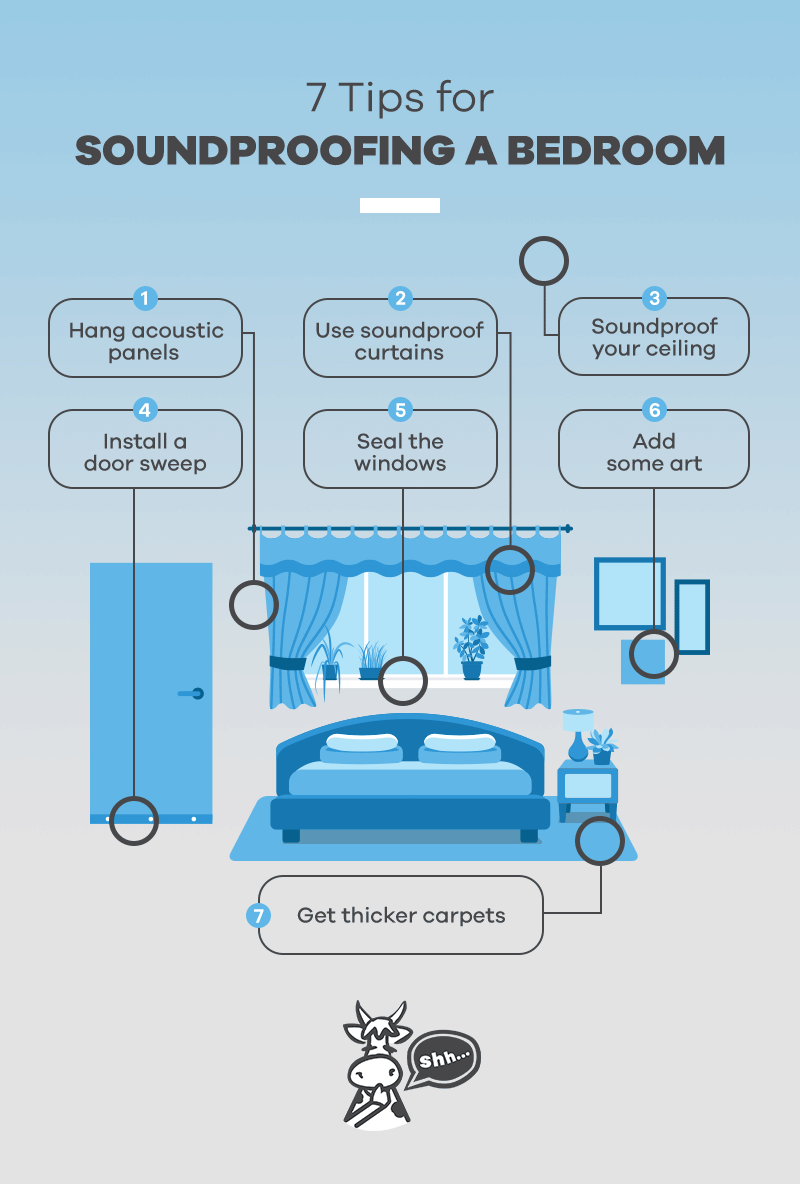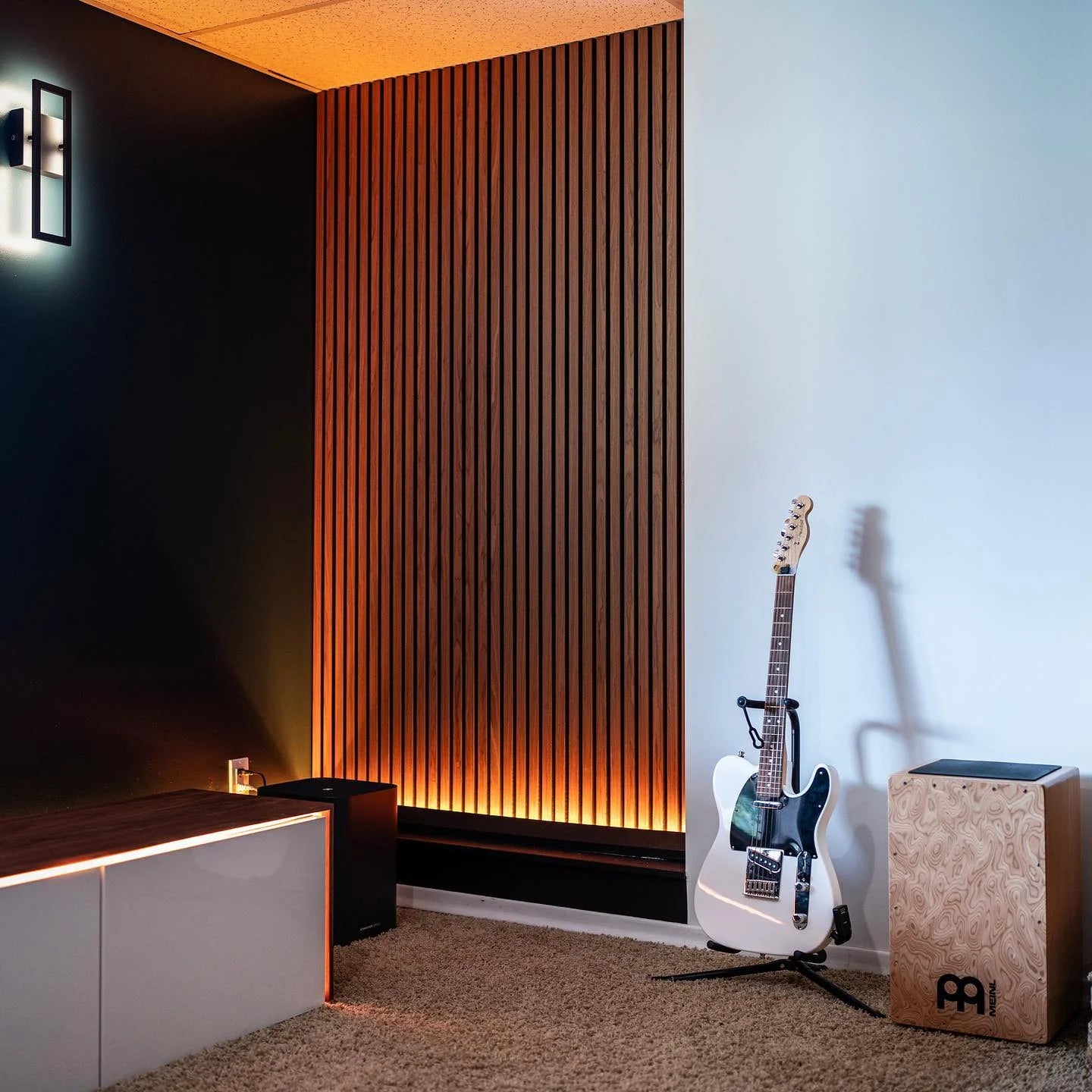Acoustic panels absorb sound waves, reducing reverberation and echoing in a room. They enhance sound quality by dampening noise levels.
Managing the acoustics of a space is crucial for comfort and audio clarity, whether in a recording studio, home cinema, or open office layout. Acoustic panels are a go-to solution for achieving such an environment. They consist of sound-absorbing materials like foam or mineral wool, which trap sound waves and prevent them from bouncing back into the space.
By installing these panels, you can significantly improve speech intelligibility and overall auditory experience. Not only do they serve a functional purpose, but acoustic panels also come in various designs, adding an aesthetic touch to interiors. Their application is widely recognized in areas where control over sound is essential, offering a simple yet effective method to attain acoustic balance and reduce noise pollution.

Credit: www.soundproofcow.com
Introduction To Acoustic Panels
Think of a library, a studio, or even a lively restaurant. The sound in these spaces can be loud or just a whisper. Acoustic panels help manage these sounds. They keep the noise comfortable for everyone. Let’s dive into how these panels work and why they are so important in modern spaces.
Essential Role In Modern Spaces
In today’s world, acoustic panels play a big role. Let’s explore why:
- Improves Sound Quality: They clean up the audio in a room.
- Reduces Noise: Loud spaces get much quieter.
- Boosts Privacy: Conversations stay private, as sound does not travel far.
- Enhances Comfort: Noisy environments become more relaxing.
Beyond these, there are more benefits. They help in places like schools and offices. Everyone can focus better without extra noise.
What Are Acoustic Panels?
Now, let’s understand what these panels are all about:
- Material: They are made from sound-absorbing materials like foam or fiber.
- Placement: You find them on walls or ceilings.
- Design: They come in various sizes and colors.
- Function: These panels trap sound waves. This stops echoes and noise.
This is the basic idea behind acoustic panels. They are tools to control sound. By using them, we create spaces where sound acts the way we want it to.

Credit: andorwillow.com
The Science Behind Sound Absorption
The Science Behind Sound Absorption can sometimes feel like magic, but it is grounded in the very real principles of physics.
Understanding Sound Waves
Sounds move through the air like ripples on water. When these sound waves hit walls or objects, they bounce back, creating echoes.
- Waves carry energy.
- Higher waves mean louder sounds.
- Soft surfaces catch sound waves.
Acoustic panels work by trapping these waves. They prevent echoes and reduce noise.
Mechanics Of Soundproofing
Soundproofing isn’t just about absorbing sound. It’s about creating a barrier.
| Material Type | Soundproofing Action |
|---|---|
| Dense | Blocks sound waves |
| Soft | Absorbs sound waves |
Acoustic panels combine these materials. They reduce sound from bouncing and escaping.
Types Of Acoustic Panels
Understanding the different types of acoustic panels is key to optimizing sound in any space. Here’s how they differ:
Fabric-wrapped Panels
Fabric-wrapped acoustic panels offer both functionality and aesthetics. They consist of:
- Absorbent acoustic foam or fiberglass core.
- Wrapped in decorative fabric.
These panels reduce echo and improve sound clarity.
Perforated Acoustic Wood Panels
Perforated acoustic wood panels blend design with sound absorption. Characteristics include:
- Wood panels with holes or grooves.
- Backed with sound-absorbing materials.
Their structure traps and diffuses sound waves.
Foam Panels
Foam panels are a popular choice for:
| Installation Area | Benefits |
|---|---|
| Studios | Simple installation |
| Home Theaters | Cost-effective |
They absorb sound frequencies to reduce noise pollution.

Credit: m.youtube.com
Installation Tips And Tricks
Welcome to our ‘Installation Tips and Tricks’ guide for acoustic panels. Proper installation can make a huge difference in sound control. Let’s dive into the best ways to install acoustic panels for maximum effectiveness.
Identifying The Strategic Spots
Before installation, finding the right spots is crucial. Strategic placement ensures optimal sound absorption.
- Check for areas with high echo.
- Consider spots directly opposite noise sources.
- Use the ‘clap test’ to identify reflective surfaces.
Placing panels at these points reduces sound reflections. This enhances the overall acoustic quality of your space.
Diy Vs. Professional Installation
Decide whether to DIY or hire a professional. This depends on your comfort level and skills.
| DIY Installation | Professional Installation |
|---|---|
|
|
DIY may seem intimidating, but detailed guides are available. Pro assistance guarantees precision and saves time.
Ensure wall surfaces are clean before installation. This improves panel adhesion. Use adhesives or mounting hardware compatible with your wall type. Follow safety protocols while using tools.
Maintenance And Care For Longevity
To keep your acoustic panels performing optimally, proper maintenance is key. Simple steps ensure longevity and maintain sound quality. Cleaning them the right way and knowing when to replace them can save time and money. This guide will outline the necessary care to help your panels last longer and work better.
Cleaning And Upkeep
Regular cleaning extends an acoustic panel’s life and preserves its appearance. Dust lightly with a soft cloth or use a vacuum with a brush attachment. Avoid harsh chemicals or water, as they can damage the fabric and the internal material. For spot cleaning, a gentle fabric cleaner is best. Test it on a small area first.
- Dust panels monthly to prevent build-up.
- Use a vacuum on a low setting for deeper cleaning.
- Spot clean when necessary with recommended solutions.
When To Replace Your Panels
Acoustic panels are durable, but they don’t last forever. Signs of wear may signal it’s time for replacement. Look for fading, fabric tears, or a decrease in sound absorption. If a panel gets damaged by water or heavy impact, consider replacing it to maintain acoustical integrity.
| Sign | Action |
|---|---|
| Fading color | Plan for replacement. |
| Material breakdown | Prioritize immediate change. |
| Reduced performance | Test acoustics, replace if needed. |
Check panels annually for signs of wear. Replacing panels in a timely manner ensures the best acoustical performance in your space.
Measuring The Effectiveness
Understanding the effectiveness of acoustic panels is crucial for optimal sound quality. The right tools and comparison methods are necessary. They help us assure the panels perform as expected.
Tools To Gauge Sound Reduction
Different tools exist for measuring sound reduction efficiency:
- Sound Level Meters: Devices that measure the intensity of sound in decibels (dB).
- Decibel Meters: Handy tools, often available as apps, to monitor sound levels before and after installation.
- Frequency Analyzers: Help to determine the frequency range that the panels are effectively absorbing.
- Room Acoustic Analysis Software: Complex software for professionals to analyze multiple sound properties and provide detailed reports.
Using the correct tool is essential for accurate measurements, ensuring that acoustic panels are meeting their purpose effectively.
Comparing Before And After Scenarios
Comparative analysis is essential to evaluate the panels’ impact on sound quality.
- Record the ambient room sound levels without panels.
- Install the acoustic panels as recommended.
- Measure the new sound levels in the same room conditions.
Noticeable differences should emerge that demonstrate the panels’ effectiveness. These may include:
| Aspect | Before | After |
|---|---|---|
| Echo | Present | Reduced/Removed |
| Clarity | Low | High |
| Sound Level | High dB | Lower dB |
Detailed comparisons lay the foundation for understanding the value that the acoustic panels bring. Moreover, they allow for further tuning to achieve the desired sonic environment.
Frequently Asked Questions For How Do Acoustic Panels Work
How Effective Are Acoustic Panels?
Acoustic panels effectively reduce unwanted echoes and improve sound quality within a space. Their efficiency depends on the panel’s material, size, and placement. Properly installed, they significantly enhance auditory experiences in environments like studios and home theaters.
Do Acoustic Panels Keep Sound In Or Out?
Acoustic panels primarily absorb sound to prevent echo and improve sound quality in a room. They can somewhat reduce sound transmission, but are not designed to block sound completely from entering or leaving a space.
What Are The Disadvantages Of Acoustic Panels?
Acoustic panels can be costly and may detract from a room’s aesthetic. Installation requires time and effort, and they might not completely block out noise. Over time, they can accumulate dust and may require professional cleaning or replacement.
How Do You Use An Acoustic Panel?
To use an acoustic panel, first identify the area with excess noise. Securely mount or hang the panel on walls or ceilings to absorb sound. Arrange panels strategically across the space for optimal sound dampening. Regular maintenance ensures long-term effectiveness.
Conclusion
Acoustic panels play a pivotal role in managing sound quality. They absorb unwanted noise, enhancing listening experiences in various settings. Effective placement transforms acoustics, whether in studios or public spaces. To optimize a space for sound, consider integrating these soundproofing allies.
Embrace the quiet with acoustic panels.